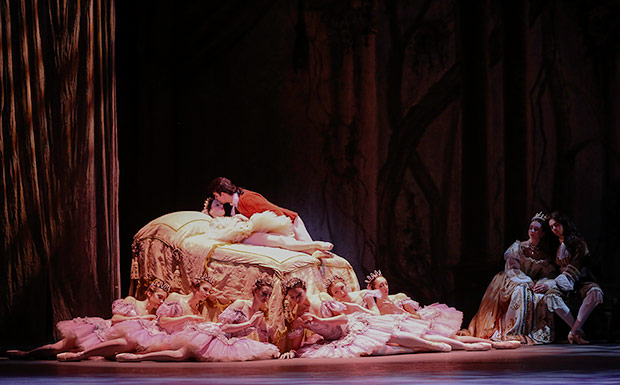
© XMB Photography. (Click image for larger version)
The Washington Ballet
The Sleeping Beauty
★★★★✰
Washington, Kennedy Center Eisenhower Theater
2 March 2018, matinee
www.washingtonballet.org
www.kennedy-center.org
The Washington Ballet has many reasons to celebrate. The company unveiled its first-ever full-length Sleeping Beauty at the Kennedy Center Eisenhower Theater last week. This sparkling production, staged with skill and care by the company’s artistic director Julie Kent and her husband, associate artistic director Victor Barbee, proved not only an important milestone in the troupe’s history but also a testament to the Washington Ballet’s growing artistic excellence.
A crown achievement of Marius Petipa, The Sleeping Beauty is universally regarded as the pinnacle of the 19th century classicism – a dazzling showcase of virtuoso dancing and an ultimate test for a ballet company. It has taken the Washington Ballet more than four decades to achieve its own Beauty. Until recently this production seemed like an unattainable dream for the troupe which is mostly versed in the contemporary ballet lexicon.
When Kent took the helm of Washington Ballet in the fall of 2016, one of her goals was to raise the standard of classical technique and shape the company into a world-class ballet institution. Judging by this production, she is on the right track.

© Victoria Pickering. (Click image for larger version)
In their quest to bring Sleeping Beauty to Washington, Kent and Barbee turned to the famous Stepanov Notation – an annotated movement “score” of the 1890 production of the Mariinsky Theatre created by Vladimir Stepanov to record and preserve the original choreography of Petipa. (In the program notes, Kent expressed deep gratitude to Alexei Ratmansky “for his time, encouragement, and suggestions on resource materials.”) They also relied on their own extensive knowledge and experience with this ballet acquired over their long careers with American Ballet Theatre.
At two and a half hours, with one intermission, the Washington Ballet’s Beauty is a lovely and intimate affair. The scenery and costumes – courtesy of Utah’s Ballet West – are attractive and effective, if not particularly grand and lavish. There are a number of cuts and abbreviations to the original text to accommodate the ballet for the size of the troupe. As such, the staging is a far cry from opulent extravaganza usually associated with this classic. Still, even in its truncated form, this Beauty proved an absorbing and handsomely-crafted spectacle, with plenty of charm and wit, with no frills and exaggerations. The story of a cursed princess who falls asleep after pricking her finger on a spindle and is awakened by true love is logically developed and told in a traditional fashion, with clear pantomime and inspired dancing.

© XMB Photography. (Click image for larger version)
The role of Princess Aurora is the beating heart of The Sleeping Beauty. It’s one of the most physically arduous and technically demanding parts in the classical canon. Relying on their own talent, without outsourcing the principal roles to big-name guest stars, Washington Ballet presented four leading casts over the course of this sold-out run. This is yet another proof of the company’s growing strength, especially in the ballerina department.
To watch Katherine Barkman’s performance as Aurora is to rediscover many nuances and felicities of this role anew. Barkman only joined the company this season after spending nearly three years as a principal dancer with Ballet Manila. At 22, she is a fully-formed ballerina, with nearly flawless technique and affable stage presence.
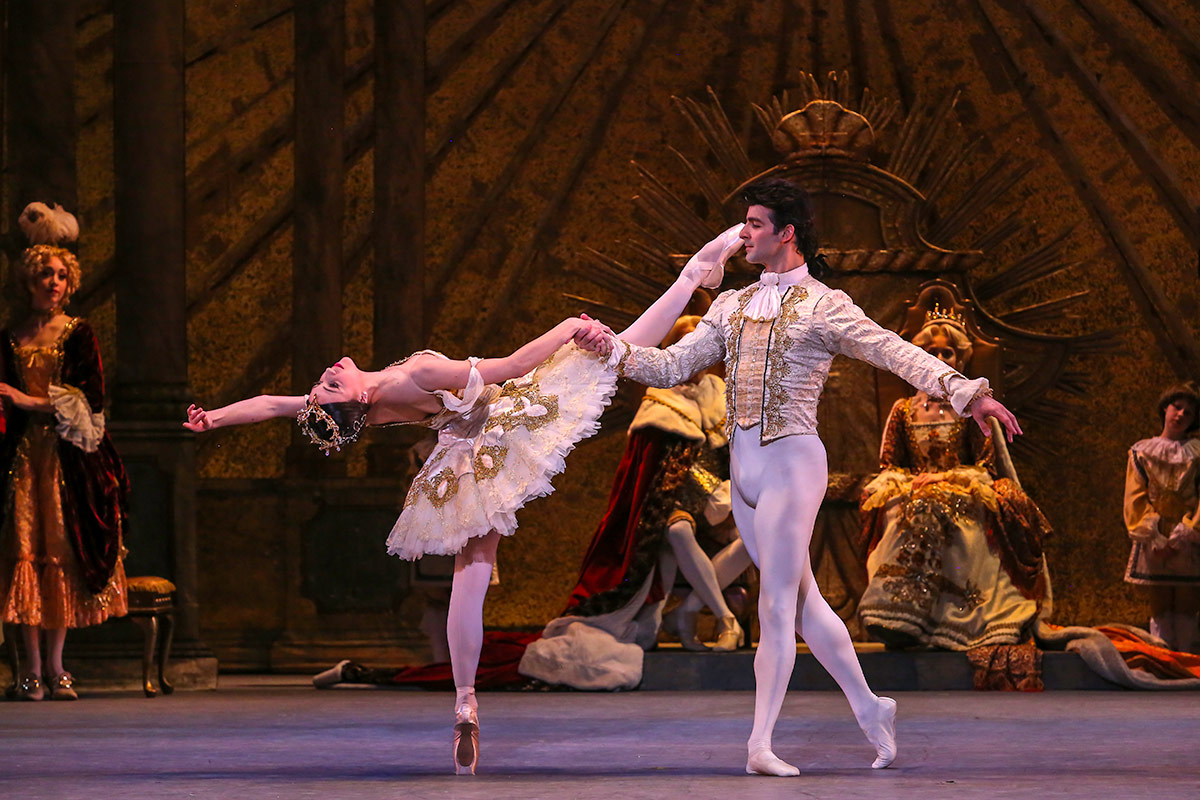
© XMB Photography. (Click image for larger version)
Petite and dark-eyed, Barkman was a picture-perfect princess, her youthful exhilaration and joy reflected in her dazzling footwork. The technical challenges of the choreography seemed like no big deal to her. Without a glimpse of hesitation, she effortlessly glided through the rigorous Rose Adagio, holding her balances steady-state and awarding her would-be-suitors with a beaming smile. She was entirely transformed in the Vision Scene, looking at once mysterious and serene, her movements soft and lyrical. In the wedding pas de deux, she danced with captivating elegance and warmth; and the chemistry between her and her Prince felt palpable and real.
As Prince Désiré, Rolando Sarabia couldn’t match the level of Barkman’s vigor and skill: his dancing felt somewhat strained and cautious. Yet he was a prince of impeccable manners and proved a capable partner.

© Victoria Pickering. (Click image for larger version)
Poised and glamorous, Kagodmotherechyna put a memorable spin on the role of the benevolent Lilac Fairy, Aurora’s godmother and protector; and Daniel Roberge was a deliciously terrifying Carabosse, the evil fairy and a symbol of darkness, whose fateful curse on the baby Aurora sets the whole story in motion.
In this reduced version, the final act’s wedding festivities looked like an intimate family gathering, with only important guests in attendance. Still, it was a lively party with first-rate entertainment. Stephanie Sorota and Alexandros Pappajohn were standouts in Jewels pas de quatre. I also admired Masanori Takiguchi’s high, spritely jumps in the famous Bluebird pas de deux and the perfect comic timing of Brittany Stone as the White Cat.

© Victoria Pickering. (Click image for larger version)
Special praise goes to the students of the Washington School of Ballet, particularly to the terrific ensemble of “Garland Children,” who enliven this production. Their dedication and enthusiasm, and their infectious love of dance made this Sleeping Beauty all the more enjoyable.








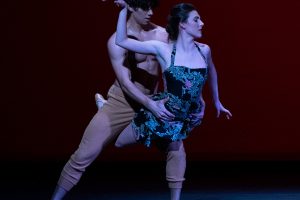
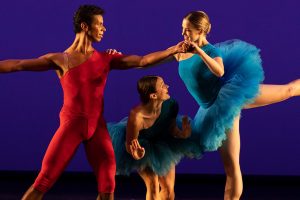
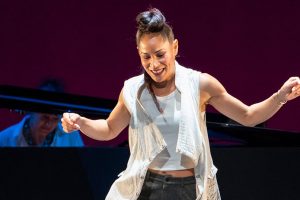
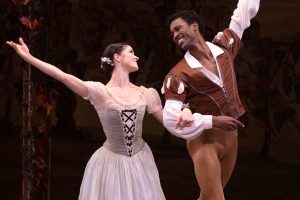
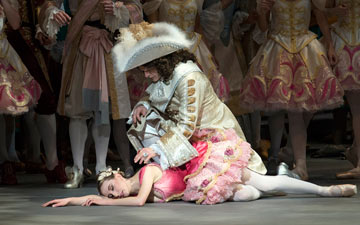
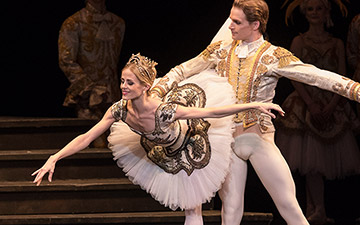



You must be logged in to post a comment.